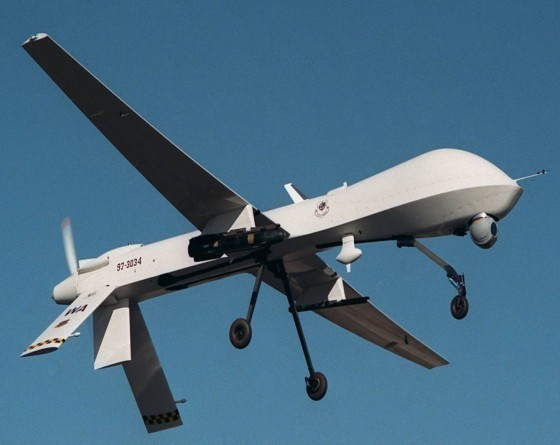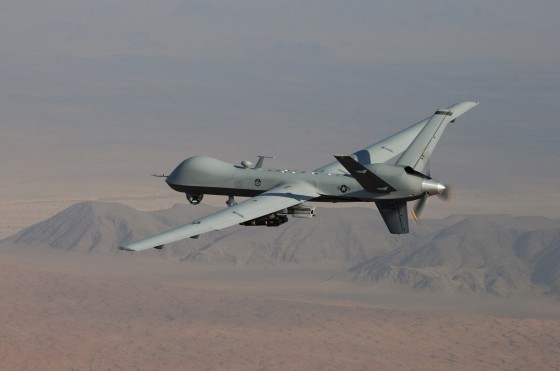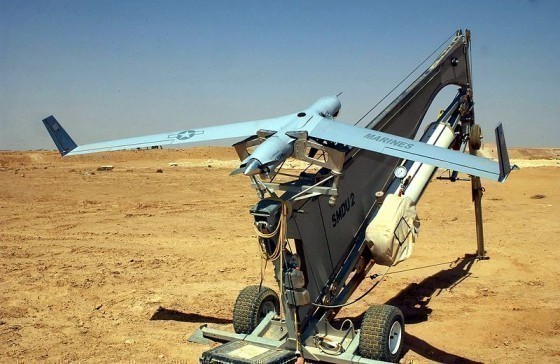The Counter Terrorism All Star – U.S. Drones
The United States drone program has seen rapid growth since the terrorist attacks of 9/11. Although the predominant missions for Unmanned Aerial Vehicles (UAVs), also known as Remotely Piloted Aerial Systems (RPAS), is intelligence and surveillance, armed employment of the drones has steadily risen since the first documented use in Afghanistan in 2002. Although armed drone employment is disparaged by many friends, foes, and those in-between of the United States, the program’s employment has proven highly successful in degrading the leadership and combat capability of the al Qaeda and associated terrorist networks that consider it their duty to wage holy war on the American people, United States, and their friends and allies.
How Do U.S. Drones Work?
The U.S. drone program was brought online to fly missions in areas deemed too difficult or risky for manned aircraft to fly. The aerial vehicles are

An MQ-1 Predator armed with an AGM-114 Hellfire missile flies a training mission. The MQ-1’s primary mission is interdiction and conducting armed reconnaissance against critical, perishable targets. (Official USAF Photo)
designed to remain airborne for a prolonged period of time typically exceeding manned flight mission times, and to send back real-time imagery and other senor information of ground or sea-based activities.
When a drone is launched, they are piloted by a trained crew which steer the aircraft and analyze the video, imagery, and other sensor data received from the craft. The ground control station used for flying the drone can be located in the combat zone or in the United States from Creech Air Force Base located in Nevada. The landings and take-offs of drones are handled at the local airport or operating area and then handed off to the remote tactical controller.
Depending on the type of drone being flow, the sensors can vary to include both color and black & white TV cameras, radar, infra-red imaging, and lasers for targeting. Some drones can be armed with laser-guided missiles or bombs such as the Paveway II or GBU-12. A typical Predator or Reaper drone system includes four aircraft, a satellite link, and a ground control station.
What Models of Drones Does the United States Fly?
The predominant drones flown by the United States today include the MQ-1B Predator, MQ-9 Reaper, RQ-4 Global Hawk, the Boeing Scan Eagle, and the RQ-170 Sentinel. The first unmanned aerial helicopter to see combat operation support by the United States in Afghanistan and Libya is the MQ-8 Fire Scout. The MQ-1 B Predator is the first model of U.S. drone to employ weapons in combat; whereas, the MQ-9 Reaper is the first unmanned system designed to be a “Hunter Killer” type of UAV from conception to employment. Unlike the Predator, the Reaper is designed to carry up to 15 x the amount of weapons to include laser-guided bombs and a greater number of air-to-surface missiles.
Armed U.S. Drone Employment

An MQ-9 Reaper, armed with GBU-12 Paveway II laser guided munitions and AGM-114 Hellfire missiles, piloted by Col. Lex Turner flies a combat mission over southern Afghanistan. (U.S. Air Force Photo / Lt. Col. Leslie Pratt)
The first publicly documented use of a U.S. drone in a targeted attack was on February 4th, 2002 in Afghanistan. Since that time, the frequency of armed U.S. drone attacks has increased in fighting the war against terrorism in Afghanistan, Pakistan, Somalia, and Yemen. Some of the high value individuals killed by armed U.S. drones include: Pakistan al Qaeda leader Badar Mansoor, senior al Qaeda leader Anwar al-Awlaki killed in Yemen by a CIA-led U.S. drone strike, al Qaeda’s operations chief for Pakistan Abu Hafs al Shahri reported killed in U.S. Predator strike, al Qaeda No. 2 Atiyah Abd al-Rahman Killed in Pakistan by CIA predator drone strike, al Qaeda Commander Ilyas Kashmiri killed in U.S. Predator Strike, and numerous other senior and mid-level al Qaeda or affiliated members. U.S. drones also played a significant role in the preparation for and execution of the combat mission resulting in Osama bin Laden’s death.
Confirmed / Possible Drone Strikes in Pakistan, Somalia, and Yemen
Pakistan Drone Strikes
Confirmed/Possible U.S. Drone Attacks: 302
Somalia Drone Strikes
Confirmed U.S. Drone Attacks: 3-9
Possible U.S. Drone Attacks: 10-21
Yemen Drone Strikes (2002-2012)
Confirmed U.S. Drone Attacks: 33-43
Possible U.S. Drone Attacks: 51-61
*Figures are as of June 2012. Due to the secretive nature of U.S. drone operations, the total drone employment numbers are referenced from the Counterterrorism Strategy Initiative based on reliable open source reporting.
Advantages of U.S. Drones
The primary advantage of the employment of armed drones is the selectivity of the objective to neutralize or eliminate when compared to other comparable weapons systems with the reduction in risk to the operator. This has allowed the current U.S. administration to eliminate a large number of the high value targets in al Qaeda or affiliated organizations since taking over the war on terrorism from President Bush. Are there civilian casualties in some of these strikes? Likely, but when compared to other weapons systems employed in war, the potential for collateral damage is much less. When compared to past wars such as World War 2, when more than 30 million civilians lost their lives in a total war environment, today’s losses are orders of magnitudes less.
On the military side, flying armed drones in less-than-hospitable locations reduces the risk to manned combat support planes while still proving capable of limited support of troops in contact on the ground at the tactical level. Other advantages include longer on-station times, more cost effective compared to manned aviation assets, and they are more fuel efficient with the possibility of being run on bio fuels in the future. Operationally, armed drones bring a longer on-station time and can be repurposed or re-tasked more quickly than piloted aircraft.
Why Do Many People Dislike Drones?
It seems to be pretty popular in the press to take a “drone hating” attitude. Common themes include the use of armed drones being immoral, illegal, or of

AL ASAD, Iraq–ScanEagle UAV sits on the catapult prior to launch. A small detachment of Marines and civilians is deployed here to provide intelligence, surveillance, and reconnaissance in western Iraq. The detachment is from Marine Unmanned Aerial Vehicle Squadron 2, 2nd Marine Aircraft Wing, Cherry Point, North Carolina. ScanEagle weighs approximately 40 pounds and has a 10-foot wingspan. The aircraft operates with a small engine, requiring a small amount fuel. Its 4-foot frame can remain airborne for more than 10 hours. Each drone is launched using a catapult system, which makes it runway independent and perfect for forward operating forces.
Author: Gunnery Sergeant Shannon Arledge of the 2nd Marine Aircraft Wing
making the use of armed force more attractive. An increasingly popular argument is that drone strikes by themselves are creating the current generation of jihadists who wish to carry out armed attacks against the United States and the west. When compared to the alternative means to carry out kinetic strikes; however, the surgical strike capability of the drones minimizes the amount of collateral damage that alternative strike options would cause.
The al Qaeda Propaganda Machine
The al Qaeda propaganda machine, otherwise known as as Sahab, has been used to deliver the terrorist organizations message of jihad to the world since 2001. The media wing of al Qaeda, focuses on leveraging the fears of the affected populations in regions of the world where the fight against terrorists and their affiliates is ongoing in order to radicalize young men and women to join the jihad against the West. The organization traditionally uses key environments to incite and recruit new members to include places of warship and prisons in areas not under strict Coalition or member-nation control.
Combatting the al Qaeda Propaganda Machine
Both the United States, UN, and European Union have released complimenting counter-terrorism strategies. The published doctrine is based around four main objectives to include: prevention, protection, pursuit, and response. The active U.S. and Allied drone program provides a key role in the protection, pursuit, and response pillars of the strategy in order to prevent al Qaeda operatives from using sanctuaries in nation-states who do not have either the means or desire to control the outlying areas of their territories to include Pakistan, Yemen, and Somalia.
To-date, the leadership of the terrorist organization has been significantly atrophied through the active targeting of key leaders throughout the organization no matter where they may seek sanctuary. A key aspect of the Allied counter insurgency policy is to build the local institutions in the affected areas of Afghanistan and other key areas around the world in order to help protect the local population and deny sanctuary to the rogue actors. Combined with the continued atrophy of the terrorist networks and active defense on the home-front, there has not been a successful attack on the United States since 9/11. This doesn’t mean that the risk of a terror attack is or ever will be 0%; however, the ability of al Qaeda to successfully plan and carry out such an operation has been significantly degraded over the past decade.
What are the Limitations of Drone Employment
To effectively employ the current generation of armed military drones requires air dominance of the planned operating area. This is due to the relatively slow speeds that the armed drones fly as compared to fighter or attack aircraft making them fairly easy to shoot down for a competent adversary. In the reported employment scenarios acknowledged by the government in the war against terror, armed drones have not been employed where they can be attacked by an opposing air force or anti-aircraft system.
Additionally, unlike the movies, the ability of drones to monitor an adversary is not omnipotent. As a result, although they fill a vital role on the battlefield for collecting intelligence and conducting surgical strikes, drones do not yet take the place of all “Man-in-the-loop” combat system. Combined with their susceptibility to modern anti-aircraft systems, and drones become merely one of the tools at the disposal of the commander to wage war, vice the only too.
Drone Technology on the Home front
More recently, there has been a lot of negative press on the government’s intention to leverage drone technology on the home-front. Despite claims to the contrary, the use of drones is not ethically different from the airborne surveillance that has already been conducted by the government for decades in the United States. The planned drone usage provides a number of benefits to include tracking fugitives, examining ecological changes in hard-to-reach locations in the country, and in disaster response. As an example, during the post-hurricane Katrina response, if drones had been used to survey the entire disaster zone, first responders would likely have seen the large crowd of refugees that were gathering at the Superdome much earlier than the days it actually took FEMA and the U.S. Department of Homeland Security to discover them.
What’s next for the U.S. Drone Program?
Armed drones have proven very effective at mitigating much of the risk to servicemen and women in the war on terrorism to date. Research and development will continue to improve the reliability, efficiency, and precise delivery of ordnance from drones in the future. As they help reduce the fratricide or collateral damage suffered from legacy weapons systems, drones will only increase as a weapons alternative for future conflicts and presidents to help ensure the national security of the United States and friends or Allies.


Comments - 15 Responses to “The Counter Terrorism All Star – U.S. Drones”
Sorry but comments are closed at this time.